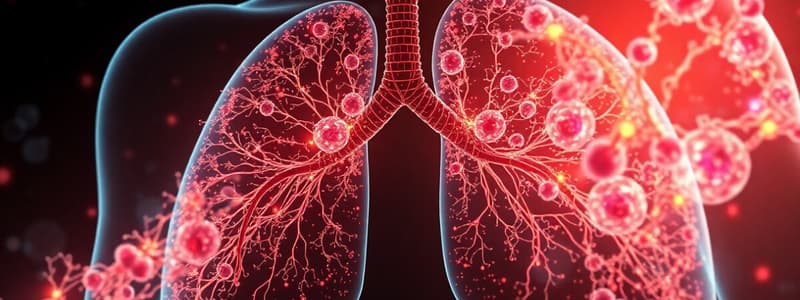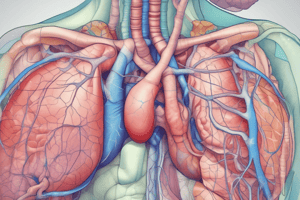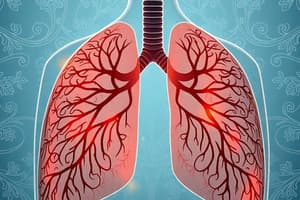Podcast
Questions and Answers
Which of the following best describes the primary function of the pulmonary surfactant system?
Which of the following best describes the primary function of the pulmonary surfactant system?
- To regulate blood flow through the pulmonary capillaries.
- To defend against microorganisms and maintain the patency of the respiratory surface. (correct)
- To facilitate gas exchange by increasing the metabolic rate of lung cells.
- To filter air entering the lungs and remove particulate matter.
What property of the pulmonary epithelium makes it a potential weak point in the body's defense?
What property of the pulmonary epithelium makes it a potential weak point in the body's defense?
- Its high concentration of immune cells makes it susceptible to autoimmune reactions.
- Its small surface area limits the amount of air that can be processed.
- Its thick, multi-layered structure impedes the efficient diffusion of oxygen.
- Its large surface area makes it highly exposed to the external environment. (correct)
The text mentions that a human lung must be able to process an equivalent of a tennis court of area for gas exchange. What is the approximate daily air turnover required to do this?
The text mentions that a human lung must be able to process an equivalent of a tennis court of area for gas exchange. What is the approximate daily air turnover required to do this?
- 11,000 liters (correct)
- 110,000 liters
- 1,100 liters
- 22,000 liters
Which characteristic of dipalmitoylphosphatidylcholine (DPPC) is essential for the function of pulmonary surfactant?
Which characteristic of dipalmitoylphosphatidylcholine (DPPC) is essential for the function of pulmonary surfactant?
The text indicates that SP-A and SP-D, unlike SP-B and SP-C, participate in which of the following?
The text indicates that SP-A and SP-D, unlike SP-B and SP-C, participate in which of the following?
Why is the presence of a surfactant system more important for terrestrial animals in contrast to aquatic organisms?
Why is the presence of a surfactant system more important for terrestrial animals in contrast to aquatic organisms?
In the context of the lung's alveolar surface, what does the Law of Laplace explain about alveoli of different sizes?
In the context of the lung's alveolar surface, what does the Law of Laplace explain about alveoli of different sizes?
According to the information provided within the text, what makes pulmonary surfactant an extremely effective tensioactive agent?
According to the information provided within the text, what makes pulmonary surfactant an extremely effective tensioactive agent?
SP-B protein is essential for proper lung function and is usually co-expressed with SP-C. According to the text, the key role of the two is:
SP-B protein is essential for proper lung function and is usually co-expressed with SP-C. According to the text, the key role of the two is:
What is the clinical significance of monitoring the levels of DPPC and other surfactant components in amniotic fluid?
What is the clinical significance of monitoring the levels of DPPC and other surfactant components in amniotic fluid?
Flashcards
Surfactante Pulmonar
Surfactante Pulmonar
Complex lipoproteico essential for mantener abierta la superficie respiratoria y defenderla frente a la entrada de organismos patógenos.
Función del Surfactante Pulmonar
Función del Surfactante Pulmonar
Reduce la tensión superficial y estabiliza la gran superficie de intercambio gaseoso del pulmón.
Surfactante Pulmonar en la Interfase
Surfactante Pulmonar en la Interfase
Forma una película en la interfase aire-líquido respiratoria, reduce la tensión superficial y facilita el intercambio gaseoso.
Proteínas Hidrofóbicas del Surfactante
Proteínas Hidrofóbicas del Surfactante
Signup and view all the flashcards
Tipos de Proteínas del Surfactante
Tipos de Proteínas del Surfactante
Signup and view all the flashcards
Evolución del Surfactante
Evolución del Surfactante
Signup and view all the flashcards
Tensioactivos
Tensioactivos
Signup and view all the flashcards
DPPC
DPPC
Signup and view all the flashcards
Maduración del Surfactante Pulmonar
Maduración del Surfactante Pulmonar
Signup and view all the flashcards
Defensa Innata y Surfactante
Defensa Innata y Surfactante
Signup and view all the flashcards
Study Notes
- Pulmonary surfactant is a complex lipoproteico that is synthesized and secreted by the pulmonary epithelium.
- It keeps the respiratory surface open and defends it against the entry of pathogenic organisms.
Basic Concepts
- Pulmonary surfactant creates a film at the air-liquid respiratory interface, reducing surface tension and stabilizing the large surface area for gas exchange in the lung during breathing cycles.
- It creates an innate defense barrier against microorganisms entering.
- The hydrophobic proteins in the surfactant enable the formation and dynamism of the tensioactive film in the lung.
- The absence of an operative surfactant leads to the development of serious respiratory disorders.
- Surfactant-deficient patients are treated with exogenous surfactants, mainly from animal sources.
- New humanized versions are being developed using human surfactant proteins and synthetic phospholipids.
Oxygen, Lungs, and Pulmonary Epithelium
- Obtaining energy for cell functions requires continuous oxygen supply to tissues.
- The lungs of air-breathing vertebrates facilitate gas exchange between air and the bloodstream.
- The pulmonary epithelium is a highly specialized structure that separates inhaled air from blood flowing through capillaries by a barrier 50 times thinner than paper.
- Oxygen diffuses across this barrier, is transported by hemoglobin in erythrocytes, and carbon dioxide is released into the environment as waste.
The Role of Surfactant
- A human lung needs to expose a surface equal to a tennis court for gas exchange and renew the air contacting that surface at a rate of 11,000 liters per day.
- The lungs operate unceasingly.
- Pulmonary surfactant, a lipoproteic lubricant, is essential for the structure of the respiratory surface.
- The primary function of pulmonary surfactant is to facilitate respiratory mechanics by minimizing energy required to keep the gas exchange surface open during breathing cycles.
- Many molecular components participate in innate defense mechanisms, providing an initial barrier against entering microorganisms.
Vulnerability of the Pulmonary Epithelium
- Respiratory needs make the pulmonary epithelium the body's largest surface exposed to the environment.
- The respiratory epithelium is a frequent entry point for infections from viruses, bacteria, fungi, and parasites, and its exposure to allergens is linked to allergies, as well as inhalation of pollutants.
- The surfactant complex is produced and secreted by specialized alveolar epithelial cells, type II pneumocytes, creating a surface film in contact with the air.
- It stabilizes the pulmonary surface against physical forces from respiratory mechanics, blocks pathogen access to epithelial cells, blood capillaries, and the rest of the body.
Molecular Structure
- The surfactant system's composition has been studied from alveolar washes of animal lungs, yielding a sample of components secreted by cells lining airways.
- Surfactant is a lipoproteic complex; in mammalian lungs, 90% of surfactant by weight is lipids, and 8-10% is proteins.
- Lipids includes 90% phospholipids and neutral lipids such as cholesterol.
- Between the phospholipids, dipalmitoilfosfatidilcolina (DPPC) makes up over 40% of the surfactant.
- Phosphatidylcholines (PC) are key lipid components in animal cell membranes, usually made of one saturated and one unsaturated fatty acid for optimal fluidity at physiological temperature.
- DPPC has two saturated fatty acid chains, essential for surfactant function. Pneumocytes produce these disaturated species through dedicated metabolic pathways.
- Phosphatidylglycerol (PG) found in surfactant is frequent in plant cells but not in animal cell membranes. Both PG and phosphatidylinositol (PI) are anionic phospholipids, possessing a polar head with a negative charge at physiological pH. Together, PG and PI account for 10-15% of the surfactant by weight.
- The surfactant also has proteins: SP-A, SP-B, SP-C, SP-D, which are in two families by structure, properties, and role in alveolar spaces.
- SP-A and SP-D are hydrophilic, form large oligomers, and have lectin domains that bind to oligosaccharide chains in the presence of calcium.
- SP-A and SP-D are essential to innate defense.
- SP-B and SP-C are small, cationic polypeptides. They are soluble in organic solvents and co-purify with lipids during surfactant organic extraction. SP-B is a dimer made of 79 amino acid monomers derived from a 358 amino acid proSP-B precursor.
Surfactant Proteins
- The four proteins are associated with lung surfactant.
- SP-A and SP-D are hydrophilic and belong to the collectin group. They have collagen-type areas and globular domains with lectin activity and can recognise and bind to certain oligosaccharide chains and form large oligomers, thus taking part in the innate defense of the lung.
- SP-B and SP-C are hydrophobic and are made of cationic polypeptides of reduced size, which pair up with the lipids from the surfactant with the alveolar air-liquid interface and determine the bio-physical proprieties of the surfactant's lipids.
Functional role: the problem of superficial tension
- The need for a surfactant system arises with air breathing.
- In aquatic animals, the contact surface between organism and environment responds to features of a liquid-liquid interface through which molecules can diffuse, enter or exit based on molecular interactions with border structures.
- Vertebrate emergence onto land creates a physical border (air-liquid interface) with special chemical-physical qualities such as surface tension.
- Water molecules in liquid phase have dynamic polar interactions among them that are continuously exchanged. The energy component in the body of the liquid phase is balanced in all space directions.
- Water molecules on the surface in contact with the air can only interact with water molecules in the liquid phase.
- The superficial molecules are subject to net cohesive components with the rest of the molecules in the liquid phase.
Opening the air-water interface
- The opening/expansion of an air-water interface involves an energetic cost from interactions that water molecules cannot have when moved to the surface.
- This energy is called surface tension and is about 17 mcal/m² (70 mN/m) for pure water at 25°C.
- The force needed to open a wet plastic bag is the work required to compensate for the surface tension of the opened surface.
- Surface tension must be compensated, and there must be gas exchange.
- This surface is "wet" or has a thin capillary water layer from interstitial fluid on the alveolar epithelium
- The surface area changes cyclically due to breathing dynamics. Lungs inflate during inspiration (maximum alveolar surface) and deflate during expiration (minimum alveolar surface).
Laplace's Law
- Lung alveoli vary in size and do not empty/fill at the same time, with the attached physical problems.
- Pressure closing an ideal spherical alveolus from surface tension is defined by Laplace's Law: P = 2y/r.
- P corresponds to chamber emptying pressure, y is surface tension, r is alveolar curvature radius.
- The larger y and the smaller r, the greater P, which creates closing or collapse.
- If two different-sized alveoli are connected, a pressure difference would empty the smaller alveolus into the larger one, leading to progressive alveolar space collapse.
- The benefits of having a tensioactive system in the lung are the reduction of the superficial tension and a system that lowers the superficial tension.
What tensioactive molecules show
- Tensioactive molecules have an amphipathic structure, having both a hydrophilic and hydrophobic part.
- This facilitates molecule orientation in the air-liquid interface.
- Tensioactive molecules offer the hydrophilic part for polar interactions with water, and directs the hydrophobic part towards the air.
- The more tensioactive molecules are located in the interface, the more water molecules are released into an aqueous state and the lower the superficial tension.
The role of detergents
- Typical tensioactive compounds are detergents, whose properties are based on the amphipathic character of their structure.
- The tensioactive capacity of detergents leads to the formation of foam.
- Tensioactive characteristics are also the stabilization of large extensions of air-liquid interface.
- Addition of detergent to a wet bag makes it easier to open without effort because it reduces tension. The pulmonary surfactant constitutes the tensioactive system optimized on the epitelio alveolar to minimize the energy to maintain the air spaces open.
Alveolar cells
- Phospholipid components can make interfacial films.
- Surfactant phospholipids are absorbed into air-water interfaces and reduce surface tension.
- Reduced surface tension is greater as alveolar volume reduces during expiration, so y/r relation is constant and pressure differences do not cause collapse.
- Lipid insolubility in the aqueous phase causes higher concentration and more surface tension reduction as respiratory surface is reduced during lung emptying.
- Disaturated phospholipid (DPPC) in surfactant is advantageous.
- Saturated fatty acid chains result in nearly linear configurations, unlike unsaturated fatty acid chains, so in the moments of max compression, the DPPC molecules can densely pack in the interface, thus decreasing tension.
More About DPPC
- The drastic superficial tension reduction keeps alveoli from collapsing and allows them to open in inspiration.
- Even at 20 mN/m, palmitoiloleoilfosfatidilcolina (POPC), insufficient to stabilize the lung.
- DPPC is very effective, but its physicochemical properties for relaxing the tension until it is almost null are counterproductive for a quick creation of tensioactive interfacial films.
- Solid state means is does not tend to be transferred to air-liquid interface.
- The rest of the surfactant species and, esp., the SP B and SP-C hydrophobic proteins come into play.
- Surfactant is synthesized, arranged.
Surfactant in the alveolar film
- About 50% of DPPC is then stored in bilayer structures (occurs with most cell phospholipid systems).
- Fluidifies DPPC-rich membranes for easier transit into the interface.
- SP-B and SP-C catalyze the transfer of tensioactive molecules, mainly the DPPC. The PG probably forms via a specific process.
- The hydrophobic surfactant proteins involved in interaction of surfactant-secreted structures and interfacial films, for transfer of tensioactive lipids to the interface. They disturb bicapal structure, favouring build of intermediaries for DPPC molecules to pass to interface.
- The pressure, however, stabilizes interface film in its low-tension state. Proteins encourage re-extension of molecule, for it to be ready for the next rotation.
Lack of Gene expression
- Lack of SP-B reduces lung surfactants, like at the moment of birth. The SP-B knockout happens in animals, and at the moment of birth, acute, irreversible, and fatal respiratory failure appears, as the proteins' production genes stop.
- The gene has been deactivated because of the lack of surfactant's action on the action of a hydrophobic agent on the surface that acts as inexorable tension's.
More factors to take into account
- The lack of the expression of the genes from the proteins stops their biological cycle
- Those cases need that, as the lack of a protein, which proceeds from distinct genes, the preparation can be interconnected. For that reasons the new-born does not fully develop since the newborn has the problems of respiratory issues, in a long-term plan and there is no right stabilization on the top of a respiratory surface. Evolution of the surfactant system is needed.
Physiopathology
- Lack of a functional surfactant system causes serious breathing problems, from difficulty keeping air spaces open.
- This happens more in infants born before 35th gestation week.
- Surfactant may change with the passing of time.
- If the air cannot be found because the fetus is not prepared to breathe.
Synthesis and gathering
- As DPPC's (tensioactive component) start around 35th gestational week.
- At this point, synthesis from proteins start.
- Some infants are inable to breath.
- Infants lungs do not yet have a surfactant function.
- Fragile tissue triggers problems from related harm.
Molecular Actions of Pulmonary Infection
- It is sufficient the material comes from an external agent., which helps the lung.
- Neonatal departments make exogenous treatment a routine, but the exogenous agent does not contain hydrophobic proteins like SP-B, SP-C.
Pulmontary Defense Mechanisms
- Epithelium needs a defense mechanism to not allow pathogens come in.
- Alveolar spaces need antibodies to not allow damage by pathogens
- Alveolar surfaces need mechanisms to block bacteria. SP-A and SP-D are important to immune agents, they get attached to carbohydrates.
- There's a sugar binding that can eliminate pathogens such as: Alveolar space by destroying cells and lungs, and bacteria.
- SP-D is aggluting mass, which helps destroy bacteria.
- SP-A attacks the cells of the system to block immunitary agents like macrophages
- The body has cells as receptors for collegenous regions.
Viral and Epithelial defense
- The body has cells as receptors for collegenous regions.
- SP-A and SP-D helps maintain the air that comes to the body.
- Some animals are extremely sensitive, the are extremely sensitive.
- It is able to cause a gram negative reaction, lipopoysaccariticide
- Hydrodphobic proteins is to join with LPS.
Studying That Suits You
Use AI to generate personalized quizzes and flashcards to suit your learning preferences.



